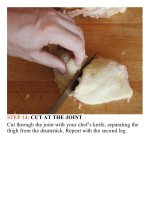The food lab better home cooking through science ( PDFDrive ) 478
Bạn đang xem bản rút gọn của tài liệu. Xem và tải ngay bản đầy đủ của tài liệu tại đây (177.34 KB, 2 trang )
fragrance evenly over the meat and further
enhancing its flavor. I also included a
nonaromaticizedsteakasacontrol.
The results were a shock: tasters unanimously
picked the nonbutter version as the most aromatic.
Someevenhadtroubletellingthedifferencebetween
the buttered version and the version with no
aromaticsatall!Howcouldthisbe?Ilookedatthe
sous-vide bags the steaks had been cooked in and
had my answer: the bag with the buttered steak
containedalargeamountofhighlyaromaticmelted
butter.Turnsoutthatratherthantravelingintothe
meat,whereIwantedittogo,thearomaendedupin
thebutter,gettingthrownawayalongwiththebag.
Conclusion:Aromaticsarefine,butleaveoutthe
butterifyouwanttomaximizetheirflavor.
COOKINGSTEAKINACOOLER
Cooking steak in a cooler is the absolute best, most
foolproof way to ensure that you get yours to exactly the
levelofdonenessthatyoulike.Aswe’vealreadydiscussed,
the degree of doneness is largely a personal matter, but if
you are the kind who likes your steaks rare, I strongly
suggest keeping an open mind about taking your steak a
shademoretowardwell-done.Atarare120°F,thebeeffat
is still relatively solid—it hasn’t begun to melt into the
surrounding meat, which means that for all intents and
purposes, it may as well not be there. Inmy book,
undercooking a heavily marbled rib-eye or expensive
Japanese-style Wagyu steak is just as much of a crime as
overcookingit.
In an impromptu blindfolded tasting I held at a dinner
party, I found that even most self-proclaimed rare steak
lovers actually preferred the texture and flavor of mediumrare (130°F) or even medium steaks (140°F) when they
couldn’t see the color of the meat they were eating.Try it
out,andseewhatyouthink.
One more thing: cooking sous-vide is ideal for cheaper
“butcher’s cuts” of beef.The expensive steak house cuts—
New York strip, rib-eye, porterhouse, T-bone, and filet
(tenderloin)—havehistoricallybeenprizedfortheirextreme
tenderness, not particularly for their flavor. But more
flavorful cuts like hanger, blade, or flatiron steak are much
more difficult to cook correctly—even a tad over- or
undercooked, and you’re left with a tough, stringy, chewy
mess. Cooked properly, though, these can be every bit as
tender as the more expensive cuts, and with more flavor to
boot!
That’s why those cuts are commonly referred to as
“butcher" or “chef” cuts—chefs and butchers love them
because they are cheap and, with proper preparation,
delicious.Withasous-videsetup,anyonecanproperlycook
these tricky cuts. Like most fatty cuts of beef, these are at
theirbestwhencookedtomedium-rareormedium.Doyou
want to pay $7 per pound for a hanger steak that is just as
tenderasandtastesmuchbetterthana$16-per-poundstrip
steak?Yes,please!









